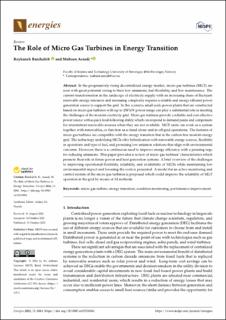| dc.contributor.author | Banihabib, Reyhaneh | |
| dc.contributor.author | Assadi, Mohsen | |
| dc.date.accessioned | 2023-01-02T10:28:01Z | |
| dc.date.available | 2023-01-02T10:28:01Z | |
| dc.date.created | 2022-11-11T19:54:03Z | |
| dc.date.issued | 2022 | |
| dc.identifier.citation | Banihabib, R., & Assadi, M. (2022). The Role of Micro Gas Turbines in Energy Transition. Energies, 15(21), 8084. | en_US |
| dc.identifier.issn | 1996-1073 | |
| dc.identifier.uri | https://hdl.handle.net/11250/3040255 | |
| dc.description.abstract | In the progressively rising decentralized energy market, micro gas turbines (MGT) are seen with great potential owing to their low emissions, fuel flexibility, and low maintenance. The current transformation in the landscape of electricity supply with an increasing share of fluctuant renewable energy resources and increasing complexity requires a reliable and energy-efficient power generation source to support the grid. In this scenario, small-scale power plants that are constructed based on micro gas turbines with up to 250 kW power range can play a substantial role in meeting the challenges of the modern electricity grid. Micro gas turbines provide a reliable and cost-effective power source with a quick load-following ability which can respond to demand peaks and compensate for intermittent renewable sources when they are not available. MGT units can work as a system together with renewables, or function as a stand-alone unit in off-grid operations. The features of micro gas turbines are compatible with the energy transition that is the carbon-free modern energy grid. The technology underlying MGTs offer hybridization with renewable energy sources, flexibility in operations and type of fuel, and promising low emission solutions that align with environmental concerns. However, there is a continuous need to improve energy efficiency with a pressing urge for reducing emissions. This paper provides a review of micro gas turbines’ characteristics which promote their role in future power and heat generation systems. A brief overview of the challenges to improving operational flexibility, reliability, and availability of MGTs while maintaining low environmental impact and lowering the costs is presented. A model for an active monitoring and control system of the micro gas turbines is proposed which could improve the reliability of MGT operation in the grid by means of AI methods. | en_US |
| dc.language.iso | eng | en_US |
| dc.publisher | MDPI | en_US |
| dc.rights | Navngivelse 4.0 Internasjonal | * |
| dc.rights.uri | http://creativecommons.org/licenses/by/4.0/deed.no | * |
| dc.title | The Role of Micro Gas Turbines in Energy Transition | en_US |
| dc.title.alternative | The Role of Micro Gas Turbines in Energy Transition | en_US |
| dc.type | Peer reviewed | en_US |
| dc.type | Journal article | en_US |
| dc.description.version | publishedVersion | en_US |
| dc.rights.holder | The author | en_US |
| dc.subject.nsi | VDP::Matematikk og Naturvitenskap: 400 | en_US |
| dc.source.volume | 15 | en_US |
| dc.source.journal | Energies | en_US |
| dc.source.issue | 21 | en_US |
| dc.identifier.doi | 10.3390/en15218084 | |
| dc.identifier.cristin | 2072704 | |
| cristin.ispublished | true | |
| cristin.fulltext | original | |
| cristin.qualitycode | 1 | |

